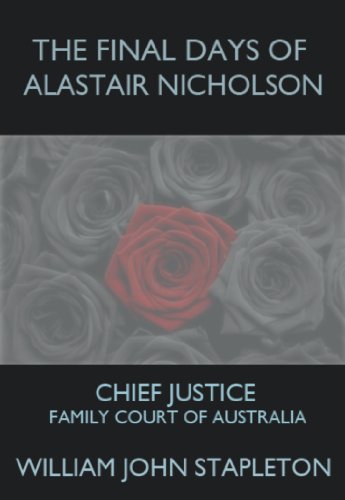Alastair Bothwick Nicholson, Chief Justice of the Family Court Australia from 1988 until 2004, is the dominant figure in the history of family law in Australia.
While the Family Court is deliberately kept out of the arena of contemporary public debate, it was not always so.
The Final Days of Alastair Nicholson: Chief Justice Family Court of Australia covers a period of intense media coverage and fervent hope that the troubled jurisdiction would be reformed.
Those dreams were dashed, with the then Prime Minister John Howard ignoring public support for shared parenting and a shift away from the traditional sole custody model.
The marginalisation and demonisation of fathers stood oddly with the country’s egalitarian traditions.
Instead Howard chose to protect the legal profession and Canberra’s strident feminist bureaucracy.
Australia adopted with alacrity the Marxist-feminist style courts which were introduced throughout the West during the 1970s, the halcyon days of the left. It has acted as a legal lynchpin for the creation of a multi-billion welfare state centred around the needs of separated parents.
The court is regularly accused by both critics within the legal profession and the lay-public as having an inherent hostility towards fathers, of being enormously overly bureaucratic and showing little regard for the real-life problems of litigants, and of having highly dubious notions of what constitutes “the best interests of the child”.
It continues, after failed reform efforts by the conservative government Howard and considerable meddling in the legislation by the Labor party and its constituents in feminist groups and the bureaucracy, the court continues to be reviled by its critics. Painful stories of fathers being denied contact with their children and with early deaths and suicides of separated parents are as easy to find now as they were 20 years ago.
The problem of “expert” witnesses and the misuse of psychiatric evidence is a problem throughout the Australian court system, and nowhere more so than in the he-said she-said jurisdiction of family law.
The notion of 1970s feminist jurisprudence, that facts are just weapons that men use to batter women and perpetuate the system, that as social justice venues they have a higher duty to equality and societal transformation, has mugged generations of separated fathers.
They do not understand that as male patriarchs they are viewed as the oppressors. They believe, naively, that truth matters.
Alastair Nicholson never let an opportunity to disseminate his views, particularly through his favourite outlet the Australian Broadcasting Corporation.
While the Family Court of Australia has been out of the media spotlight in recent years, with Nicholson’s replacement as Chief Justice Diana Bryant deliberately, through silence, denuking the hostility and controversy surrounding it, one cannot understand the nature of the court today without understanding its history.
Nicholson’s retirement in 2004 was met with considerable pomp and circumstance, and displays of preening sycophancy from legal luminaries, politicians and feminist groups.
Father’s groups universally despised the court and the Chief Justice, and were more than happy to see the back of him.
Nicholson is now approaching his 79th birthday.
This essay on his final days as Chief Justice, written by veteran journalist John Stapleton, the co-founder of the radio program Dads on the Air, is a timely look at its legacy from outside the official narrative.
The essay opens with scenes from the last major inquiry into family law.
Refusing to hide, Chief Justice of the Family Court of Australia Alastair Nicholson, scheduled to appear before an inquiry into family law and child support, entered Australia’s Parliament House in Canberra via the front door on the 10th October, 2003.
As Chief Justice of one of the most unpopular courts in the country, Nicholson had become a key figure fueling discontent with Australia’s political, bureaucratic and judicial wings of government. With millions of Australians having gone through the shredder of the country’s divorce regime, he had become a focus for community discontent.
So heightened had the debate around Nicholson become that politicians rightly feared the general public were losing faith in the country’s governance.
Nicholson was arguably the single most outspoken, certainly the most controversial judge ever to serve in the Australian court system; deeply hated by some, admired by others. Politicians from both sides of politics had reason to fear his ever ready tongue.
The appearance before the Inquiry of the one man who had done more to shape the nature of Australian family law than any other individual had been looked forward to by his critics with a kind of wonder and anticipation, a fascination for the grotesque.
Despite a plethora of Inquiries, including a devastating critique from the government’s chief adviser on legal matters the Australian Law Reform Commission, doubt was not a trait Nicholson ever displayed in public.
Was this the inquiry which would finally nail him to the wall?
To the chagrin of his critics, Nicholson showed not a sliver of regret or self-doubt, either then or since.





